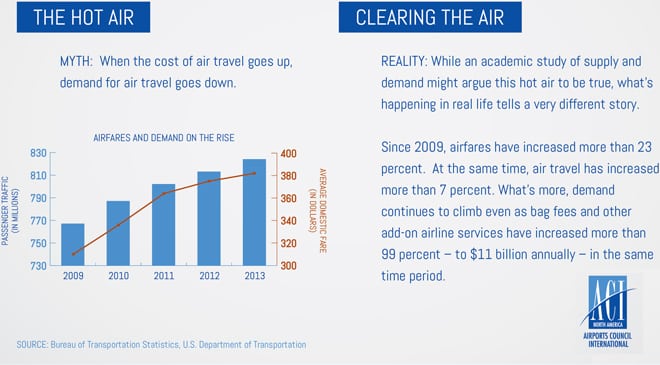Increasing the passenger facility charge cap would significantly increase PFC collections available to airports but could also marginally slow passenger growth and therefore the growth in revenues to the Airport and Airway Trust Fund, the U.S. government’s General Accounting Office found.
In a report released earlier this week, the GAO found that trust-fund revenues are expected to continue to grow from 2016 through 2024 regardless of any changes to the PFC because of strong passenger growth projections. However, the report notes that cap increases, studied at various levels, could reduce total AATF revenues by roughly 1 percent because of reduced passenger demand.
“These projected effects depend on key assumptions regarding consumers’ sensitivity to a PFC cap increase, whether airlines would pass on the full increase to consumers and the rate at which airports would adopt the increased PFC cap,” the report notes.
With the current cap of $4.50 per flight segment, about $2.8 billion was collected by airlines on behalf of airports in 2013, the report says.
Researchers examined three increase scenarios. At a $6.47 cap (the $4.50 cap adjusted for inflation), PFC collections in 2016 would increase by $1.34 billion from the $3.07 billion baseline estimate if the cap remained at $4.50. However, AATF revenues would drop by an estimated $90 million. At an $8 cap, which is the level proposed by President Barack Obama, PFC collections would increase by $2.36 billion and AATF collections drop by a projected $161 million. At an inflation-adjusted cap of $8.50, the level proposed by airport industry trade organizations, PFC collections are projected to rise by $2.7 billion, but AATF collections would drop by $184 million.
The airline industry long has argued that U.S. airports have ample resources to fund their capital needs and that a higher PFC cap would negatively impact demand for air travel. The GAO report took the expected demand decline into account when assessing the impact.
But Airports Council International-North America, a longtime advocate for a PFC cap increase, says data suggests that higher fares aren’t curbing travel. ACI-NA says that since 2009, airfares have increased by more than 23 percent, and at the same time air travel has increased more than 7 percent. ACI-NA adds that demand continues to climb despite airline ancillary fees of roughly $11 billion annually.
The GAO report also includes a study of PFC collection methods. PFCs are charged at the time of purchase of an airline tickets.
“Stakeholders GAO interviewed generally said that alternative methods to collect PFCs, such as airport kiosks or online or mobile payments, are technologically feasible but they would impose additional steps for passengers, costs for airports and changes in business processes,” the report says. “Therefore, stakeholders said that the current collection method is better than the identified alternatives.”
The GAO report said airlines are required to have audits of their PFC collections but noted that some airports might not be aware of their ability to view audits.
“GAO recommends that [the Federal Aviation Administration] review the extent to which airline independent audits of PFC collections follow FAA guidance and take additional steps to educate airports about their right to review these audits,” the report says.






